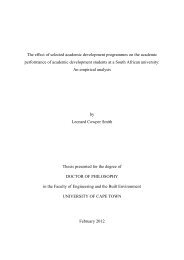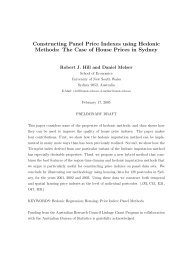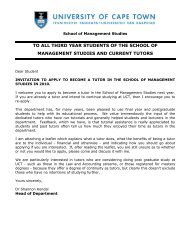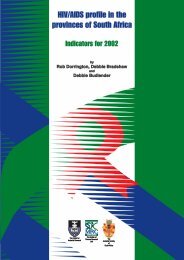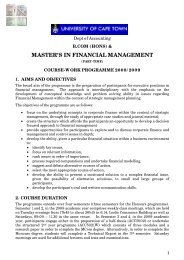Adoption Factors for Mobile Gaming in South Africa - University of ...
Adoption Factors for Mobile Gaming in South Africa - University of ...
Adoption Factors for Mobile Gaming in South Africa - University of ...
You also want an ePaper? Increase the reach of your titles
YUMPU automatically turns print PDFs into web optimized ePapers that Google loves.
Internet and In<strong>for</strong>mation Technology <strong>in</strong> Modern Organizations: Challenges & Answers 13<br />
<strong>Adoption</strong> <strong>Factors</strong> <strong>for</strong> <strong>Mobile</strong> <strong>Gam<strong>in</strong>g</strong> <strong>in</strong> <strong>South</strong> <strong>Africa</strong><br />
Stanley Van Wyk; <strong>University</strong> <strong>of</strong> Cape Town; <strong>South</strong> <strong>Africa</strong>; Email: stanleyv@directaxis.co.za<br />
Jean-Paul Van Belle; <strong>University</strong> <strong>of</strong> Cape Town; <strong>South</strong> <strong>Africa</strong>; E-mail: jvbelle@commerce.uct.ac.za<br />
Abstract<br />
The mobile communications market has reached a<br />
fairly mature state with regards to text and voice<br />
services and there<strong>for</strong>e new services are<br />
cont<strong>in</strong>uously <strong>in</strong>vestigated to <strong>in</strong>crease the number <strong>of</strong><br />
revenue streams generated from the exist<strong>in</strong>g mobile<br />
phones. One <strong>of</strong> the possible revenue streams is<br />
mobile gam<strong>in</strong>g and it is there<strong>for</strong>e essential to<br />
understand the factors that <strong>in</strong>fluence its adoption.<br />
The study focuses on two important adoption factors<br />
which are deemed pert<strong>in</strong>ent to the <strong>South</strong> <strong>Africa</strong>n<br />
telecommunications environment namely the cost <strong>of</strong><br />
the service and the social <strong>in</strong>fluence <strong>of</strong> this service.<br />
The nature <strong>of</strong> the research question lends itself to a<br />
research strategy based on survey sampl<strong>in</strong>g to<br />
collect data us<strong>in</strong>g questionnaires with<strong>in</strong> a crosssectional<br />
time horizon.<br />
The results from the study <strong>in</strong>dicated that the factors<br />
<strong>in</strong>fluenc<strong>in</strong>g the adoption patterns <strong>for</strong> the <strong>South</strong><br />
<strong>Africa</strong>n mobile gam<strong>in</strong>g users are significantly<br />
different than those found <strong>in</strong> a comparative study<br />
conducted <strong>in</strong> Norway <strong>in</strong> 2002.<br />
Key words: <strong>Mobile</strong> Technology, <strong>Mobile</strong> Video<br />
Services, <strong>Mobile</strong> Commerce, Diffusion <strong>of</strong><br />
Innovation Theory, Technology Acceptance.<br />
1. Introduction<br />
The <strong>South</strong> <strong>Africa</strong>n telecommunications scene has<br />
seen an astonish<strong>in</strong>g adoption rate <strong>of</strong> mobile<br />
telephones. Accord<strong>in</strong>g to the latest research, the<br />
current number <strong>of</strong> mobile handsets <strong>in</strong> use <strong>in</strong> <strong>South</strong><br />
<strong>Africa</strong> is estimated at 18.7 million, <strong>of</strong> which 80%<br />
are active customers [1]. For a country with a<br />
population <strong>of</strong> 45 million people this is a phenomenal<br />
percentage, especially when compared to an Internet<br />
population estimated at around 3 million.<br />
<strong>Mobile</strong> services evolved from be<strong>in</strong>g used primarily<br />
as a voice communication medium to <strong>in</strong>clude a wide<br />
range <strong>of</strong> services such as messag<strong>in</strong>g services,<br />
payment services and also gam<strong>in</strong>g services. The<br />
wide scale adoption <strong>of</strong> both the voice and text<br />
services (SMS) is well documented while the<br />
<strong>in</strong>troduction <strong>of</strong> the new mobile services is ga<strong>in</strong><strong>in</strong>g<br />
momentum rapidly <strong>in</strong> some <strong>of</strong> the first world<br />
countries like the USA and Europe and mobile<br />
gam<strong>in</strong>g is lead<strong>in</strong>g the pack. For the purpose <strong>of</strong> this<br />
paper mobile gam<strong>in</strong>g services <strong>in</strong>cludes all <strong>for</strong>ms <strong>of</strong><br />
gam<strong>in</strong>g. Accord<strong>in</strong>g to one <strong>of</strong> the biggest mobile<br />
gam<strong>in</strong>g providers <strong>in</strong> <strong>South</strong> <strong>Africa</strong>, however, it does<br />
not look as if the <strong>South</strong> <strong>Africa</strong>n mobile gam<strong>in</strong>g<br />
market is follow<strong>in</strong>g the global trend [2].<br />
Because the mobile gam<strong>in</strong>g market is relatively<br />
new, only limited research has been done. In order<br />
to successfully research the adoption process <strong>for</strong><br />
mobile gam<strong>in</strong>g, a number <strong>of</strong> different theories and<br />
research models were <strong>in</strong>vestigated to identify the<br />
model that best describes and predicts the adoption<br />
process. Traditionally the diffusion and adoption<br />
research were used <strong>in</strong> the study <strong>of</strong> ICT services [3]<br />
while the uses and gratifications[4] and<br />
domestication research[5] were applied to the study<br />
<strong>of</strong> adoption trends <strong>of</strong> mobile services.<br />
2. Objectives and Hypotheses<br />
The objectives <strong>of</strong> this research can be stated as<br />
follows:<br />
• To assess, through quantitative research, how<br />
important two particular variables, namely<br />
Subjective Norm and Facilitat<strong>in</strong>g Conditions,<br />
are <strong>for</strong> the adoption patterns among young<br />
people <strong>in</strong> <strong>South</strong> <strong>Africa</strong>.<br />
• To compare the relative importance <strong>of</strong> these<br />
factors <strong>in</strong> <strong>South</strong> <strong>Africa</strong>n study to a similar<br />
Norwegian study.<br />
A number <strong>of</strong> technology adoption models are<br />
expla<strong>in</strong>ed <strong>in</strong> more detail below, but the two<br />
variables <strong>of</strong> <strong>in</strong>terest, as def<strong>in</strong>ed <strong>in</strong> the literature<br />
review, are the Subjective Norm and Facilitat<strong>in</strong>g<br />
Conditions (these are def<strong>in</strong>ed later). It can be<br />
argued that <strong>South</strong> <strong>Africa</strong>ns are more socially attuned<br />
than Norwegians because <strong>of</strong> the <strong>South</strong> <strong>Africa</strong>n<br />
culture and spirit <strong>of</strong> “ubuntu” (literally: “the<br />
people”). Also, because <strong>of</strong> the dist<strong>in</strong>ctly lower<br />
levels <strong>of</strong> <strong>in</strong>come <strong>in</strong> <strong>South</strong> <strong>Africa</strong>, it is considered<br />
that cost (one <strong>of</strong> the ma<strong>in</strong> facilitat<strong>in</strong>g conditions) is<br />
likely to be a much more important consideration <strong>in</strong><br />
<strong>South</strong> <strong>Africa</strong> than <strong>in</strong> the relatively wealthy Norway.<br />
The hypotheses can be stated as follows;<br />
H1 A :<br />
Subjective Norm is <strong>in</strong>fluential <strong>in</strong> the<br />
adoption process <strong>of</strong> mobile gam<strong>in</strong>g.
Internet and In<strong>for</strong>mation Technology <strong>in</strong> Modern Organizations: Challenges & Answers 14<br />
H1 B :<br />
H2 A :<br />
H2 B :<br />
Resource-related (Facilitat<strong>in</strong>g Conditions)<br />
<strong>in</strong>fluences are typically important <strong>in</strong> the<br />
adoption <strong>of</strong> mobile gam<strong>in</strong>g.<br />
Subjective Norm is more <strong>in</strong>fluential on<br />
Intention to Use <strong>in</strong> the <strong>South</strong> <strong>Africa</strong>n study<br />
than is evident from the results from the<br />
Norwegian study<br />
Resource-related <strong>in</strong>fluences (Facilitat<strong>in</strong>g<br />
Conditions) are more important (on mobile<br />
game adoption) <strong>in</strong> <strong>South</strong> <strong>Africa</strong> than it is <strong>in</strong><br />
Norway.<br />
3. Review <strong>of</strong> Relevant Literature<br />
The adoption trends <strong>of</strong> <strong>in</strong><strong>for</strong>mation technologies has<br />
been researched widely. A number <strong>of</strong> theoretical<br />
models have been suggested to identify the most<br />
<strong>in</strong>fluential factors <strong>in</strong> the adoption process. The<br />
models have evolved through the various studies<br />
and are likely to cont<strong>in</strong>ue be<strong>in</strong>g ref<strong>in</strong>ed <strong>in</strong> the quest<br />
to establish the most comprehensive model available<br />
to predict human adoption behavior. This section<br />
reviews the traditional research models to identify<br />
the most appropriate factors with<strong>in</strong> the context <strong>of</strong><br />
<strong>South</strong> <strong>Africa</strong>.<br />
The Uses and Gratifications Research has been<br />
applied to study the uses and gratifications from<br />
different media or technologies like video games,<br />
Internet [6], household telephones [7] and mobile<br />
phones [4]. L<strong>in</strong> [8] op<strong>in</strong>es that the “general idea is<br />
that adopters seek gratifications <strong>in</strong> mass media and<br />
technology use based <strong>in</strong> <strong>in</strong>dividual needs or<br />
motivations.” A study done by Dimmick and Sikand<br />
[7] <strong>in</strong>vestigated the gratification <strong>of</strong> the household<br />
telephone and the result from the study highlighted<br />
three general gratifications: “sociability”,<br />
“<strong>in</strong>strumentality” and “reassurance”. This study<br />
was conducted be<strong>for</strong>e the widespread adoption <strong>of</strong><br />
the mobile telephones but one can expect to have<br />
similar needs and motivations from a mobile<br />
telephone. Similarly, the expectation is that mobile<br />
games adoption may to some extent depend on the<br />
<strong>in</strong>dividual needs and motivations, thus the relevance<br />
<strong>of</strong> Uses and Gratifications research.<br />
Similarly, Domestication Research is useful to the<br />
current <strong>in</strong>quiry s<strong>in</strong>ce the focus <strong>of</strong> these studies is <strong>in</strong><br />
the adoption <strong>of</strong> an object <strong>in</strong>to everyday life [9] such<br />
as technology services like fixed telephony [10],<br />
television and home computers [11]. However, due<br />
to the lack <strong>of</strong> domestication research with<strong>in</strong> the<br />
mobile gam<strong>in</strong>g area, the only significant area <strong>of</strong><br />
<strong>in</strong>vestigation is the f<strong>in</strong>d<strong>in</strong>gs from a study conducted<br />
by L<strong>in</strong>g [12] on the adoption <strong>of</strong> text messag<strong>in</strong>g<br />
services. The results highlighted the importance <strong>of</strong><br />
a mobile phone as a token <strong>of</strong> “fashion and style”.<br />
The results from the study proved the importance <strong>of</strong><br />
us<strong>in</strong>g a mobile phone is mov<strong>in</strong>g away from the<br />
utilitarian value to a very strong social value.<br />
In the case <strong>of</strong> <strong>Adoption</strong> Research, common models<br />
and theories that have been applied <strong>in</strong>clude the<br />
Theory <strong>of</strong> Reasoned Action (TRA) and the Theory<br />
<strong>of</strong> Planned Behaviour (TPB). Ajzen & Fishbe<strong>in</strong> [13]<br />
created TRA where the focus was on the<br />
behavioural <strong>in</strong>tentions rather than attitudes as the<br />
primary determ<strong>in</strong>ant <strong>of</strong> behaviours. The Theory <strong>of</strong><br />
Reasoned Action has not been widely used to test<br />
the adoption <strong>of</strong> ICT services but Liker and S<strong>in</strong>di<br />
[14] used it to <strong>in</strong>vestigate the user adoption trends <strong>of</strong><br />
expert systems. The TRA was modified <strong>in</strong>to what<br />
became known as TPB, s<strong>in</strong>ce TRA was limited<br />
s<strong>in</strong>ce it did not <strong>in</strong>clude the construct <strong>of</strong> behavioural<br />
control [15]. There<strong>for</strong>e, an additional construct <strong>of</strong><br />
perceived behavioural control was <strong>in</strong>troduced,<br />
which resulted <strong>in</strong> the modified model <strong>of</strong> TPB [16,<br />
17]. A subset <strong>of</strong> the modified model (Fig 1) was<br />
applied <strong>in</strong> this <strong>in</strong>quiry.<br />
External Influence<br />
Interpersonal<br />
Influence<br />
Subjective<br />
Norm<br />
Intention to Use<br />
Use<br />
Self Control<br />
Self Efficacy<br />
Behavioural<br />
Control<br />
Facilitat<strong>in</strong>g<br />
Conditions<br />
Figure 1: Modified Model <strong>of</strong> Decomposed Theory <strong>of</strong> Planned Behaviour<br />
Subjective Norm<br />
Ajzen [18] purports that the Subjective Norm<br />
construct is “the perceived social pressure to engage<br />
<strong>in</strong> behaviour” and is determ<strong>in</strong>ed by ‘the total set <strong>of</strong><br />
accessible normative beliefs concern<strong>in</strong>g the<br />
expectations <strong>of</strong> important referents”. This construct<br />
there<strong>for</strong>e creates the social pressure that governs<br />
people to act with<strong>in</strong> a certa<strong>in</strong> virtual boundary <strong>in</strong>
Internet and In<strong>for</strong>mation Technology <strong>in</strong> Modern Organizations: Challenges & Answers 15<br />
order to con<strong>for</strong>m to the expectations <strong>of</strong> those people<br />
important to them. The Subjective Norm construct<br />
is captured by the three factors <strong>of</strong> external <strong>in</strong>fluence,<br />
<strong>in</strong>terpersonal <strong>in</strong>fluence and self control.<br />
External Influence<br />
Accord<strong>in</strong>g to Pedersen et al [19] there are two<br />
aspects to external <strong>in</strong>fluence that contributes to the<br />
importance <strong>of</strong> Subjective Norm. The first is how a<br />
the users need to get access to what he refers to as<br />
‘symbolic capital’ while the second aspect focuses<br />
on how external pressure <strong>in</strong>fluences the way users<br />
develop a specific norm and consequently show a<br />
specific behaviour.<br />
It is the second aspect <strong>of</strong> external <strong>in</strong>fluence that was<br />
considered significant <strong>in</strong> this study due to the young<br />
target market. The <strong>in</strong>fluence <strong>of</strong> market<strong>in</strong>g and<br />
advertis<strong>in</strong>g <strong>of</strong> mobile services has largely focused<br />
on the younger market because they are more<br />
vulnerable to external <strong>in</strong>fluences like mass<br />
market<strong>in</strong>g, advertis<strong>in</strong>g, peer pressure <strong>in</strong> the process<br />
<strong>of</strong> develop<strong>in</strong>g subjective norm[4].<br />
Interpersonal Influence<br />
F<strong>in</strong>d<strong>in</strong>gs by Pedersen et al [19] <strong>in</strong> respect <strong>of</strong><br />
<strong>in</strong>terpersonal <strong>in</strong>fluence are that others can also<br />
<strong>in</strong>fluence a user <strong>in</strong> terms <strong>of</strong> the norms that the use <strong>of</strong><br />
a particular service is expected. This may <strong>in</strong>clude<br />
<strong>for</strong> <strong>in</strong>stance the vulnerability <strong>of</strong> the younger users to<br />
social pressure from friends. Other aspects <strong>in</strong>clude<br />
the importance <strong>of</strong> ga<strong>in</strong><strong>in</strong>g symbolic and social<br />
capital by us<strong>in</strong>g a product or service.<br />
Self Control<br />
The aspect <strong>of</strong> Self Control has been described by<br />
[20] as the belief that the adoption or use <strong>of</strong> a<br />
service or product will lead to the desired effect.<br />
Self control is an important determ<strong>in</strong>ant <strong>of</strong><br />
<strong>in</strong>dividuality and <strong>in</strong>dependence <strong>for</strong> younger users<br />
where the use <strong>of</strong> the mobile phone is concerned<br />
[20]. It is suggested here that Self Control as<br />
determ<strong>in</strong>ant <strong>of</strong> subjective norm is more applicable<br />
to the mobile phone device itself than mobile<br />
gam<strong>in</strong>g services.<br />
Behavioural Control<br />
The modified model has perceived behavioural<br />
control as one <strong>of</strong> the underly<strong>in</strong>g constructs<br />
<strong>in</strong>troduced by Taylor et al [16]. Azjen [18] def<strong>in</strong>es<br />
behavioural control as a person’s “perceptions <strong>of</strong><br />
their ability to per<strong>for</strong>m a given behaviour”. The<br />
emphasis there<strong>for</strong>e is on attitud<strong>in</strong>al <strong>in</strong>fluences but<br />
with<strong>in</strong> the physical limitations and <strong>in</strong> the case <strong>of</strong><br />
mobile gam<strong>in</strong>g the attitude towards mobile gam<strong>in</strong>g<br />
might be limited by the knowledge <strong>of</strong> the high costs<br />
<strong>in</strong>volved <strong>in</strong> us<strong>in</strong>g the services or the lack <strong>of</strong><br />
knowledge <strong>of</strong> what service is available. There are<br />
two aspects to behavioural control i.e. self-efficacy<br />
and facilitat<strong>in</strong>g conditions.<br />
Self-efficacy<br />
Accord<strong>in</strong>g to Pedersen et al [19] the uses and<br />
gratification effect <strong>of</strong> social capital extends <strong>in</strong>to the<br />
element <strong>of</strong> self-efficacy as a determ<strong>in</strong>ant <strong>of</strong> social<br />
norm. The <strong>in</strong>fluence <strong>of</strong> social capital can <strong>in</strong>fluence<br />
the <strong>in</strong>dividual’s perception or self-confidence that a<br />
specific behaviour will have the desired result. The<br />
desired result will be <strong>in</strong>fluenced by the group’s<br />
perspective <strong>of</strong> the desired result and there<strong>for</strong>e once<br />
aga<strong>in</strong>, the strong <strong>in</strong>fluence <strong>of</strong> peer pressure comes to<br />
the <strong>for</strong>e.<br />
The <strong>in</strong>dividual’s perception <strong>of</strong> the desired behavior<br />
derived from adopt<strong>in</strong>g mobile gam<strong>in</strong>g is an<br />
important determ<strong>in</strong>ant <strong>of</strong> the adoption trends. The<br />
young <strong>in</strong>dividual will be more <strong>in</strong>cl<strong>in</strong>ed to adopt the<br />
mobile gam<strong>in</strong>g services if it is well received with<strong>in</strong><br />
the social group <strong>of</strong> friends.<br />
Facilitat<strong>in</strong>g Conditions<br />
Probably the most important aspect <strong>of</strong> the research<br />
study <strong>in</strong> <strong>South</strong> <strong>Africa</strong>, as with any other technology<br />
product or service is that the adoption rate is<br />
determ<strong>in</strong>ed by the facilitat<strong>in</strong>g conditions.<br />
Facilitat<strong>in</strong>g conditions <strong>in</strong> this <strong>in</strong>stance refers to<br />
price, service availability, awareness, support,<br />
security and service compatibility [19].<br />
One <strong>of</strong> the two major concerns <strong>for</strong> this research is to<br />
study the importance <strong>of</strong> these facilitation conditions<br />
<strong>in</strong> the light <strong>of</strong> the relatively low <strong>in</strong>come levels and<br />
the relatively high costs <strong>of</strong> mobile services.<br />
• The cost <strong>of</strong> the service: The cost <strong>of</strong> operat<strong>in</strong>g<br />
mobile phones is extremely high when<br />
compared to other countries. Cost is a huge<br />
factor prohibit<strong>in</strong>g the adoption <strong>of</strong> other services<br />
like WAP and GPRS, which <strong>in</strong> turn limits the<br />
adoption rates <strong>of</strong> mobile gam<strong>in</strong>g services.<br />
Another cost element that will be <strong>in</strong>vestigated is<br />
the impact <strong>of</strong> hidden costs or at least the<br />
perception <strong>of</strong> hidden costs on the motivation to<br />
start us<strong>in</strong>g and cont<strong>in</strong>ue us<strong>in</strong>g the service [19].<br />
• Availability: Availability refers to the<br />
availability <strong>of</strong> products and services important<br />
to the adoption and use <strong>of</strong> mobile gam<strong>in</strong>g like<br />
handsets and connectivity. The availability <strong>of</strong><br />
handsets with high resolution colour displays<br />
created a plat<strong>for</strong>m more appropriate <strong>for</strong> mobile<br />
gam<strong>in</strong>g. The gap between the quality <strong>of</strong> the<br />
display on console games and mobile phones is<br />
clos<strong>in</strong>g, however; it may still take a while <strong>for</strong><br />
the current generation <strong>of</strong> handsets to be
Internet and In<strong>for</strong>mation Technology <strong>in</strong> Modern Organizations: Challenges & Answers 16<br />
replaced,. Although this has a significant<br />
impact on the motivation to adopt mobile<br />
gam<strong>in</strong>g, it is a structural context variable and<br />
was there<strong>for</strong>e not considered <strong>in</strong> this research.<br />
• Awareness: Awareness refers to the general<br />
awareness <strong>of</strong> what gam<strong>in</strong>g services are<br />
available. This <strong>in</strong>cludes the available channels<br />
to download more games, the method used to<br />
download these games or the availability <strong>of</strong><br />
<strong>for</strong>ums and <strong>in</strong>terest groups. The <strong>South</strong> <strong>Africa</strong>n<br />
market<strong>in</strong>g around mobile gam<strong>in</strong>g has not (yet?)<br />
been given the same exposure compared to the<br />
market<strong>in</strong>g <strong>of</strong> mobile services like r<strong>in</strong>g tones,<br />
operator logos and voicemail messages.<br />
Implications <strong>of</strong> Literature Review to the Research<br />
Because <strong>of</strong> the specific “develop<strong>in</strong>g world” context<br />
<strong>of</strong> <strong>South</strong> <strong>Africa</strong> when compared to the develop<strong>in</strong>g<br />
countries, the authors decided to <strong>in</strong>vestigate very<br />
specifically the importance <strong>of</strong> Subjective Norm and<br />
Behavioural Control constructs <strong>in</strong> the current<br />
adoption pattern <strong>of</strong> mobile gam<strong>in</strong>g. The authors<br />
considered that it is the importance <strong>of</strong> Subjective<br />
Norm and Behavioral Control that may provide<br />
useful <strong>in</strong><strong>for</strong>mation <strong>in</strong> the process <strong>of</strong> understand<strong>in</strong>g<br />
the adoption trends <strong>in</strong> <strong>South</strong> <strong>Africa</strong>. It is believed<br />
that the more social culture <strong>of</strong> <strong>South</strong> <strong>Africa</strong> may<br />
<strong>in</strong>crease the importance <strong>of</strong> the Subjective Norm<br />
when compared to more “Western” countries. Also,<br />
the relatively high cost <strong>of</strong> the telecommunications<br />
<strong>in</strong>frastructure when compared to average <strong>in</strong>come<br />
levels, appears to be threaten<strong>in</strong>g to hamper the<br />
growth and development <strong>of</strong> the mobile services.<br />
4. Research Methodology<br />
This research study adopted a positivist approach by<br />
rely<strong>in</strong>g on the models and <strong>in</strong>struments which were<br />
developed <strong>in</strong> the context <strong>of</strong> the Decomposed Theory<br />
<strong>of</strong> Planned Behavior and apply<strong>in</strong>g them to a mobile<br />
gam<strong>in</strong>g environment.<br />
Research Strategy<br />
The study used a survey strategy. The research<br />
<strong>in</strong>strument is based on the structured questionnaire<br />
used <strong>in</strong> the Norwegian study [24] to ensure<br />
comparable results from a <strong>South</strong> <strong>Africa</strong>n<br />
perspective.<br />
The questionnaire gathers <strong>in</strong><strong>for</strong>mation regard<strong>in</strong>g the<br />
different constructs <strong>of</strong> the Decomposed Theory <strong>of</strong><br />
Planned Behaviour to determ<strong>in</strong>e the factors that<br />
<strong>in</strong>fluence the user behaviour and <strong>in</strong>tention to adopt<br />
new mobile gam<strong>in</strong>g technology.<br />
The research was a cross-sectional study, conducted<br />
from July to September 2004. [21]. The sample<br />
selection process used a simple random sampl<strong>in</strong>g<br />
approach. The target population was young people<br />
although these can be separated <strong>in</strong>to three groups;<br />
• School children between the ages <strong>of</strong> 16 and<br />
18 years<br />
• Young adults between the ages <strong>of</strong> 19 and<br />
25<br />
• People over the age <strong>of</strong> 25<br />
The rationale <strong>for</strong> categoriz<strong>in</strong>g the respondents <strong>in</strong><br />
three dist<strong>in</strong>ct groups is based on the belief that the<br />
social environment <strong>for</strong> each <strong>of</strong> the groups differ and<br />
that the elements that <strong>in</strong>fluence the decision mak<strong>in</strong>g<br />
also differ across each <strong>of</strong> the groups.<br />
Research Sampl<strong>in</strong>g Issues<br />
When us<strong>in</strong>g the simple random sampl<strong>in</strong>g approach<br />
to data gather<strong>in</strong>g a number <strong>of</strong> issues were<br />
encountered. These issues related to ga<strong>in</strong><strong>in</strong>g access<br />
to respondents across all the age categories. The<br />
respondents <strong>in</strong> the higher age groups were not<br />
enticed by the prize on <strong>of</strong>fer compared to the<br />
younger audience and there<strong>for</strong>e the response rate<br />
from the higher age groups (25 plus) were extremely<br />
low compared to that <strong>of</strong> the younger age group (19<br />
to 25 years). Questionnaires were distributed<br />
amongst students from the three largest universities<br />
<strong>in</strong> the Western Cape prov<strong>in</strong>ce (which <strong>in</strong>cludes<br />
students from all over <strong>South</strong> <strong>Africa</strong>), <strong>in</strong> a call centre<br />
<strong>in</strong> order to obta<strong>in</strong> young <strong>in</strong>dividuals without any<br />
<strong>for</strong>mal tertiary education, and some questionnaires<br />
were distributed via mobile phone distributors to<br />
obta<strong>in</strong> responses from under-18s.<br />
Despite the limited reach <strong>of</strong> the study with<strong>in</strong> the<br />
Western Cape and the lack <strong>of</strong> a pr<strong>of</strong>ile <strong>of</strong> the current<br />
mobile gam<strong>in</strong>g market, the study aimed to deliver<br />
results that will be representative <strong>of</strong> the <strong>South</strong><br />
<strong>Africa</strong>n population.<br />
The survey <strong>in</strong>strument measured Intention to Use<br />
and Actual Use by provid<strong>in</strong>g a list <strong>of</strong> services that<br />
are available and request<strong>in</strong>g the user to complete the<br />
usage on a 7 po<strong>in</strong>t Likert scale vary<strong>in</strong>g from 1 -<br />
Never to 7 - Always. This was identical to the<br />
Norwegian study [24] which <strong>for</strong>med the basis <strong>for</strong><br />
this research study.<br />
5. Discussions <strong>of</strong> Results<br />
Descriptive Analysis<br />
A total <strong>of</strong> 204 valid questionnaires were obta<strong>in</strong>ed.<br />
With 101 female and 103 male respondents, there is<br />
an almost perfect spread <strong>in</strong> terms <strong>of</strong> gender; though<br />
it is unknown whether this is representative <strong>of</strong> the<br />
actual mobile phone user population. The survey
Internet and In<strong>for</strong>mation Technology <strong>in</strong> Modern Organizations: Challenges & Answers 17<br />
was successful <strong>in</strong> target<strong>in</strong>g a young population: 83%<br />
<strong>of</strong> the respondents were between 19 to 25 years <strong>of</strong><br />
age, and a further 13% between 16 and 18. Of the<br />
respondents, 62% used prepaid services with the<br />
other 38% hav<strong>in</strong>g a contract.<br />
Exactly 75% <strong>of</strong> the respondents played games on<br />
their mobile phones, though a full 88% <strong>of</strong> these<br />
played only the games that came pre-<strong>in</strong>stalled on<br />
their phone; only 1% <strong>of</strong> the games played onl<strong>in</strong>e<br />
and the other 11% <strong>of</strong> them had downloaded games.<br />
Instrument Reliability Analysis<br />
As discussed <strong>in</strong> the Literature Review the decision<br />
was made to focus only on the Subjective Norm<br />
(SN) and Behavioral Control (BC) measure <strong>of</strong> the<br />
Decomposed Theory <strong>of</strong> Planned Behavior.<br />
There<strong>for</strong>e the measures that have been <strong>in</strong>vestigated<br />
<strong>in</strong>clude External Influence that was based on two<br />
major sources <strong>of</strong> <strong>in</strong>fluence namely the media and<br />
society [22]. The measures used <strong>in</strong> the Norwegian<br />
study which <strong>for</strong>med the basis <strong>for</strong> this research was<br />
based on orig<strong>in</strong>al measures proposed by Taylor and<br />
Todd [16] but extended by Battacherjee [23]. Self<br />
Control focused on measures that <strong>in</strong>cluded peer<br />
pressure, <strong>in</strong>fluence from groups and superiors [24].<br />
Self-Efficacy was similarly based on the measure<br />
orig<strong>in</strong>ated from Taylor and Todd [16] and extended<br />
by Battacherjee [23]. Facilitat<strong>in</strong>g Conditions<br />
focused on the importance <strong>of</strong> <strong>in</strong>frastructure <strong>of</strong><br />
mobile service and service provider <strong>in</strong>volvement.<br />
The test items <strong>for</strong> Facilitat<strong>in</strong>g Conditions (as well as<br />
all other, dependent variables) were basically as the<br />
items used by both Battacherjee [23] and Taylor and<br />
Todd [16] but adjusted to the mobile gam<strong>in</strong>g<br />
services context by Pedersen et al [24]. Although it<br />
is acknowledged that culture and use <strong>of</strong> language <strong>in</strong><br />
<strong>South</strong> <strong>Africa</strong> may lead to a different <strong>in</strong>terpretation<br />
<strong>of</strong> the test items here when compared to Europe,<br />
most <strong>of</strong> them are fairly factual <strong>in</strong> content. Thus it<br />
was decided to stick as closely to the orig<strong>in</strong>al item<br />
phras<strong>in</strong>g as possible <strong>in</strong> order to allow the<br />
comparison with the Norwegian study without<br />
<strong>in</strong>troduc<strong>in</strong>g possible additional unknown biases.<br />
Note also that many <strong>of</strong> the responses were obta<strong>in</strong>ed<br />
verbally and transcribed onto the <strong>in</strong>strument by one<br />
<strong>of</strong> us. Dur<strong>in</strong>g this process there did not seem to be<br />
any evidence <strong>of</strong> possible misunderstand<strong>in</strong>gs or<br />
cultural bias <strong>in</strong> understand<strong>in</strong>g any <strong>of</strong> the test items.<br />
Thus, all the items <strong>of</strong> this study are based on<br />
previously validated measures <strong>of</strong> which the<br />
reliabilities were considered acceptable [19].<br />
However, as a double-check, a factor analysis<br />
exercise was done on all five <strong>in</strong>dependent variables<br />
(i.e. not the dependent variables) from the model <strong>in</strong><br />
order to evaluate their <strong>in</strong>dividual factor load<strong>in</strong>gs.<br />
Table 1 identifies the <strong>in</strong>dividual factors, the<br />
questions that measured the factors and the factor<br />
load<strong>in</strong>gs. Factor load<strong>in</strong>gs <strong>of</strong> less than 0.5 were not<br />
<strong>in</strong>cluded. The factor load<strong>in</strong>g analysis identified five<br />
factors which mapped almost perfectly on the five<br />
<strong>in</strong>dependent measures thus confirm<strong>in</strong>g the validity<br />
<strong>of</strong> group<strong>in</strong>g these measures together to test the<br />
construct validity. The only exception was found <strong>in</strong><br />
four <strong>of</strong> the Self-Efficacy test items which loaded on<br />
the Self-Control construct <strong>in</strong>stead. However, s<strong>in</strong>ce<br />
this construct is not part <strong>of</strong> any <strong>of</strong> the hypothesis<br />
tests, it was not seen as a major problem. Test items<br />
which had a factor load<strong>in</strong>g <strong>of</strong> less than 0.5 have not<br />
been <strong>in</strong>cluded <strong>in</strong> the research.<br />
Table 1: Factor Load<strong>in</strong>gs<br />
External Influence (SN) Factor 1<br />
New Service Availability? 0.58<br />
Well In<strong>for</strong>med? 0.69<br />
Marketed Or Not? 0.74<br />
Heavy User 0.70<br />
Interpersonal Influence (SN) Factor 2<br />
Never Heard Of It? -0.50<br />
What Is Available? -0.85<br />
Phone Compatibility? -0.81<br />
Where to get it? -0.84<br />
Not Advertised? -0.55<br />
Self-Control (SN) Factor 3<br />
Talk About Game? 0.63<br />
Show Games? 0.54<br />
Express? 0.62<br />
Impress People? 0.75<br />
Group? 0.79<br />
Practice? 0.60<br />
Self-Efficacy (BC)<br />
Factor 3 ctd<br />
Top Per<strong>for</strong>mer? 0.86<br />
Progress? 0.63<br />
Classmates Op<strong>in</strong>ion? 0.76<br />
Friends recommend? 0.81<br />
Factor 4<br />
Feel Free? 0.86<br />
My Control? 0.86<br />
Means & Resources? 0.66<br />
Facilitat<strong>in</strong>g Conditions (BC) Factor 5<br />
Support & Assistance? 0.86<br />
Access? 0.63<br />
Integrated? 0.61<br />
Service Provider? 0.79<br />
Compatibility? 0.61<br />
Regression Analysis and Model Test<strong>in</strong>g<br />
This section uses regression analysis to determ<strong>in</strong>e<br />
the degree <strong>of</strong> association between each <strong>of</strong> constructs<br />
with<strong>in</strong> the <strong>South</strong> <strong>Africa</strong>n environment and to<br />
determ<strong>in</strong>e the expla<strong>in</strong>ed variances.<br />
Due to the nature <strong>of</strong> this study, regression analysis<br />
was deemed acceptable as the study does not aim at<br />
deriv<strong>in</strong>g a new model but rather focus on compar<strong>in</strong>g<br />
results from <strong>in</strong>dividual constructs between the two<br />
studies; previous research used structural equation
Internet and In<strong>for</strong>mation Technology <strong>in</strong> Modern Organizations: Challenges & Answers 18<br />
modell<strong>in</strong>g to derive the model. Figure 2 summarizes<br />
the f<strong>in</strong>d<strong>in</strong>gs. Note that the existence and direction <strong>of</strong><br />
the relations are stipulated by the theoretical model.<br />
For clarity and due to space considerations, only the<br />
relationships and variables relat<strong>in</strong>g to the<br />
hypotheses are shown <strong>in</strong> Figure 2 and discussed<br />
below. However, the research also found<br />
consistently high (all >66%) and significant<br />
(p
Internet and In<strong>for</strong>mation Technology <strong>in</strong> Modern Organizations: Challenges & Answers 19<br />
The result there<strong>for</strong>e proves the acceptance <strong>of</strong> the<br />
stated hypothesis that the construct <strong>of</strong> Facilitat<strong>in</strong>g<br />
Conditions is an important determ<strong>in</strong>ant <strong>of</strong><br />
Behavioral Control.<br />
Hypothesis test 2 A :<br />
H2 A :<br />
Subjective Norm is more <strong>in</strong>fluential on<br />
Intention to Use <strong>in</strong> <strong>South</strong> <strong>Africa</strong> than it is <strong>in</strong><br />
Norway<br />
Because the same measures were used here as <strong>in</strong> the<br />
Norwegian study, the correlations can be compared<br />
directly (Table 4).<br />
Table 4: Norway compared with <strong>South</strong> <strong>Africa</strong><br />
Comparative Results<br />
r(X,Y)<br />
Subjective Norm <br />
Intention to Use<br />
Facilitat<strong>in</strong>g<br />
Conditions <br />
Behavioural Control<br />
Behavioural Control<br />
Intention to Use<br />
Behavioural Control<br />
Use<br />
Norway <strong>South</strong><br />
<strong>Africa</strong><br />
-0.01 0.39<br />
0.27 0.87<br />
0.16 0.33<br />
-0.16 0.33<br />
Contrary to the expectations based on the theoretical<br />
model, the Norwegian Study showed a negative<br />
correlation between the Subjective Norm and<br />
Intention to Use (as well as between Behavioural<br />
Control and Use). Note that positive correlations<br />
were found <strong>for</strong> other mobile services. By contrast, a<br />
moderate positive association <strong>of</strong> 0.39 <strong>in</strong> the <strong>South</strong><br />
<strong>Africa</strong>n study.<br />
It can be shown that the correlation strength <strong>in</strong><br />
<strong>South</strong> <strong>Africa</strong> is statistically significantly larger than<br />
<strong>in</strong> Norway. Although there appears to be no<br />
statistical test to test the <strong>in</strong>equality between<br />
correlation coefficients directly, it can be confirmed<br />
that the Norwegian parameter falls outside the<br />
confidence <strong>in</strong>terval <strong>in</strong> the sampl<strong>in</strong>g distribution <strong>of</strong> r<br />
<strong>for</strong> the <strong>South</strong> <strong>Africa</strong>n data. Unlike many other<br />
statistical summary parameters, the sampl<strong>in</strong>g<br />
distribution <strong>of</strong> the correlation coefficient is not very<br />
well behaved: it is usually quite skewed and its<br />
standard deviation varies greatly depend<strong>in</strong>g on the<br />
exact value <strong>of</strong> the underly<strong>in</strong>g population correlation<br />
coefficient. However, Fisher’s z trans<strong>for</strong>mation<br />
function maps the r onto a variable z r = 0.5 * ln<br />
[(1+r)/(1-r)], which is approximately normally<br />
distributed. Although the standard deviation <strong>of</strong> the<br />
trans<strong>for</strong>med variable z r depends on the population<br />
correlation coefficient (ρ), it can be approximated<br />
by the <strong>for</strong>mula ρ z = (n – 3) -0.5 when N > 50.<br />
For the <strong>South</strong> <strong>Africa</strong>n sample, the correlation<br />
coefficient <strong>of</strong> Subjective Norm Intention to Use<br />
is r = 0.3886, the correspond<strong>in</strong>g z r -value is 0.4101.<br />
The standard deviation <strong>for</strong> z r is 0.0839. S<strong>in</strong>ce we are<br />
test<strong>in</strong>g an <strong>in</strong>equality, we can use a one-tailed<br />
<strong>in</strong>terval test. At 1% confidence level (p=0.01), the<br />
lower boundary <strong>of</strong> our confidence <strong>in</strong>terval is 0.4101<br />
- 2.33 * 0.0705 = 0.2458. This corresponds (by<br />
revers<strong>in</strong>g the z-trans<strong>for</strong>mation) to a correlation<br />
coefficient <strong>of</strong> 0.241 i.e. it is less than 1% probable<br />
that the population correlation coefficient is below<br />
0.241. S<strong>in</strong>ce the Norwegian correlation coefficient<br />
falls well below the bottom <strong>in</strong>terval boundary, the<br />
null hypothesis must be rejected and thus our ma<strong>in</strong><br />
hypothesis is confirmed.<br />
Hypothesis test 2 B :<br />
H2 B : Resource-related <strong>in</strong>fluences (Facilitat<strong>in</strong>g<br />
Conditions) are more important (on<br />
Behavioural Control, Intention to Use and<br />
Use) <strong>in</strong> <strong>South</strong> <strong>Africa</strong> than they are <strong>in</strong><br />
Norway.<br />
This hypothesis <strong>in</strong>vestigates the importance <strong>of</strong><br />
Facilitat<strong>in</strong>g Conditions on Behavioral Control as<br />
well as Intention to Use and Actual Use when<br />
compared with the Norwegian study. The<br />
underly<strong>in</strong>g measures <strong>in</strong>cluded <strong>in</strong> the constructs were<br />
the same as those applied <strong>in</strong> the Norwegian study<br />
and there<strong>for</strong>e delivered comparative results.<br />
The <strong>South</strong> <strong>Africa</strong>n study delivered a much stronger<br />
association between Facilitat<strong>in</strong>g Conditions and<br />
Behavioral Control (association <strong>of</strong> 0.87 compared to<br />
the association <strong>of</strong> 0.27 from the Norwegian study).<br />
A similar approach can be used to check the<br />
confidence <strong>in</strong>terval <strong>in</strong> the sampl<strong>in</strong>g distribution <strong>of</strong> r<br />
<strong>for</strong> the <strong>South</strong> <strong>Africa</strong>n data and see if the Norwegian<br />
parameter falls with<strong>in</strong> the confidence <strong>in</strong>terval.<br />
For the <strong>South</strong> <strong>Africa</strong>n sample, the correlation<br />
coefficient <strong>of</strong> Facilitat<strong>in</strong>g Conditions with<br />
Behavioural Control is 0.8676. The correspond<strong>in</strong>g<br />
z r -value is 1.3233. The lower confidence <strong>in</strong>terval<br />
boundary (at p=1%) is then = 1.1589 and the<br />
correspond<strong>in</strong>g r is 0.8207. The Norwegian<br />
correlation coefficient <strong>of</strong> 0.27 falls well outside the<br />
confidence <strong>in</strong>terval and we can thus conclude aga<strong>in</strong><br />
that the Norwegian correlation is significantly lower<br />
that the <strong>South</strong> <strong>Africa</strong>n correlation coefficient.<br />
Similar calculations show that the correlations <strong>of</strong><br />
Behaviour Control with both Intention to Use and<br />
actual Use <strong>of</strong> mobile gam<strong>in</strong>g are also statistically<br />
significantly larger <strong>in</strong> <strong>South</strong> <strong>Africa</strong> than <strong>in</strong> Norway<br />
(p
Internet and In<strong>for</strong>mation Technology <strong>in</strong> Modern Organizations: Challenges & Answers 20<br />
Thus the hypothesis that resource-based Facilitat<strong>in</strong>g<br />
Conditions have a much larger impact on the<br />
adoption <strong>of</strong> mobile gam<strong>in</strong>g services <strong>in</strong> <strong>South</strong> <strong>Africa</strong><br />
than <strong>in</strong> Norway is strongly supported.<br />
6. Conclusion<br />
Even though the mobile gam<strong>in</strong>g market is relatively<br />
immature, it is essential to develop the <strong>in</strong>frastructure<br />
and to position the service to exploit the<br />
opportunities with<strong>in</strong> the mobile communication<br />
<strong>in</strong>dustry. In order to fully exploit the opportunities<br />
it is important to understand what cause people to<br />
behave <strong>in</strong> a certa<strong>in</strong> way or which factors will<br />
<strong>in</strong>fluence somebody’s behavior towards adopt<strong>in</strong>g a<br />
product or service. This research <strong>in</strong>vestigated the<br />
potential reasons <strong>for</strong> an <strong>in</strong>dividual’s behaviour<br />
towards use and <strong>in</strong>tention to use mobile gam<strong>in</strong>g<br />
services and to identify how to change the behavior<br />
or attitude towards use.<br />
The results from this study showed that Subjective<br />
Norm is a moderately important determ<strong>in</strong>ant <strong>of</strong><br />
Intention to Use mobile gam<strong>in</strong>g, though not as<br />
strong as found <strong>in</strong> a previous Norwegian study.<br />
However, resource-based Facilitat<strong>in</strong>g Conditions<br />
were shown to be more important <strong>in</strong> <strong>South</strong> <strong>Africa</strong><br />
than <strong>in</strong> the previous Norwegian study. The results<br />
from the hypotheses test<strong>in</strong>g suggest that there are a<br />
comb<strong>in</strong>ation <strong>of</strong> factors that <strong>in</strong>fluence the behaviour<br />
towards use and <strong>in</strong>tention to use a specific service.<br />
The literature review identified the importance <strong>of</strong><br />
the f<strong>in</strong>ancial, societal and even the political<br />
environment on the domestication process be<strong>for</strong>e a<br />
service is embraced and used frequently.<br />
Furthermore it is important to note that research<br />
studies conducted <strong>in</strong> different countries have the<br />
potential to deliver completely different results due<br />
to the difference <strong>in</strong> these other factors.<br />
In conclusion this research study proves that an<br />
<strong>in</strong>dividual’s behaviour is a result <strong>of</strong> the comb<strong>in</strong>ation<br />
<strong>of</strong> the <strong>in</strong>dividual’s societal, motivational and<br />
attitud<strong>in</strong>al factors and the facilitation conditions<br />
such as the availability <strong>of</strong> <strong>in</strong>frastructure, pric<strong>in</strong>g and<br />
the awareness <strong>of</strong> the service.<br />
7. References<br />
[1] CellularOnl<strong>in</strong>e. Statistics <strong>of</strong> Cellular <strong>in</strong> <strong>South</strong><br />
<strong>Africa</strong>, 2003. Retrieved Aug 21, 2005, from:<br />
http://www.cellular.co.za/stats/statistics_south_afric<br />
a.htm.<br />
[2] Ryan Birk<strong>in</strong> (Exact<strong>Mobile</strong>). Personal<br />
communication, 3-July-2004.<br />
[3] Rogers, E. M. Diffusion <strong>of</strong> <strong>in</strong>novations The Free<br />
Press, New York, 1995.<br />
[4] Leung, L., & Wei, R., “More than Just Talk on<br />
the Move: Uses and Gratifications <strong>of</strong> the Cellular<br />
Phone”, Journalism & Mass Communication<br />
Quarterly, 77(2): 308-320, 2000.<br />
[5] Haddon, L. Domestication and mobile<br />
telephony. Presented at the conference "Mach<strong>in</strong>es<br />
that Become Us", Rutgers <strong>University</strong>, New Jersey,<br />
April 18-19, 2001. Retrieved Aug 21, 2005, from:<br />
http://members.aol.com/leshaddon/Domestication.ht<br />
ml]<br />
[6] Papacharissi, Z. & Rub<strong>in</strong>, A.M., “Predictors <strong>of</strong><br />
Internet use”, Journal <strong>of</strong> Broadcast<strong>in</strong>g & Electronic<br />
Media, 44: 175-196, 2000.<br />
[7] Dimmick, J.W., Sikand, J., & Patterson, S.J..<br />
“The gratifications <strong>of</strong> the household telephone”.<br />
Communication Research, 21: 643-663, 1994.<br />
[8] L<strong>in</strong>, C.A., “Look<strong>in</strong>g back: The contribution <strong>of</strong><br />
Blumler and Katz's uses <strong>of</strong> mass communication to<br />
communication research”, Journal <strong>of</strong> Broadcast<strong>in</strong>g<br />
& Electronic Media, 40: 574-582, 1996.<br />
[9] Silverstone, R., & Hirch, E. Consum<strong>in</strong>g<br />
Technologies, Media and In<strong>for</strong>mation <strong>in</strong> Domestic<br />
Spaces, Routledge, London, 1992.<br />
[10] Fisher, C., America call<strong>in</strong>g: A social history <strong>of</strong><br />
the telephone to 1940, <strong>University</strong> <strong>of</strong> Cali<strong>for</strong>nia<br />
Press, Berkeley, 1998.<br />
[11] Silverstone, R., & Haddon, L. “Television,<br />
Cable and AB Households: A Report <strong>for</strong> Telewest”,<br />
August, <strong>University</strong> <strong>of</strong> Sussex, 1996.<br />
[12] L<strong>in</strong>g, R.,“It is ‘<strong>in</strong>.’ It doesn’t matter if you need<br />
it or not, just that you have it.”: Fashion and the<br />
domestication <strong>of</strong> the mobile telephone among teens<br />
<strong>in</strong> Norway. Oslo: Work<strong>in</strong>g Paper, Telenor R&D,<br />
Norway, 2001.<br />
[13] Ajzen, I., & Fishbe<strong>in</strong>, M., Understand<strong>in</strong>g<br />
Attitudes and Predict<strong>in</strong>g Social Behaviour, Prentice-<br />
Hall, Englewood Cliffs (New Jersey), 1980.<br />
[14] Liker, J. K., and S<strong>in</strong>di, A. A., “User acceptance<br />
<strong>of</strong> expert systems: a test <strong>of</strong> the theory <strong>of</strong> reasoned<br />
action”, Journal <strong>of</strong> Eng<strong>in</strong>eer<strong>in</strong>g and Technology<br />
Management, 14: 147-173, 1997.
Internet and In<strong>for</strong>mation Technology <strong>in</strong> Modern Organizations: Challenges & Answers 21<br />
[15] God<strong>in</strong>, G., Kok, G.. “The theory <strong>of</strong> planned<br />
behavior: A review <strong>of</strong> its applications to healthrelated<br />
behaviors”, American Journal <strong>of</strong> Health<br />
Promotion, 11(2): 87-98, 1996.<br />
[16] Taylor, S. and Todd, P.A. “Understand<strong>in</strong>g<br />
<strong>in</strong><strong>for</strong>mation technology usage: a test <strong>of</strong> compet<strong>in</strong>g<br />
models”, In<strong>for</strong>mation Systems Research, 6: 144-<br />
176, 1995.<br />
[17] Ajzen I., “Perceived behavioural control, selfefficacy,<br />
locus <strong>of</strong> control, and the theory <strong>of</strong> planned<br />
behaviour”, Journal <strong>of</strong> Applied Social Psychology,<br />
32:665-683, 2002.<br />
[18] Ajzen, I. The theory <strong>of</strong> planned behaviour.<br />
Organization Behaviour and Human Decision<br />
Processes, 50:179-211, 1991.<br />
[19] Pedersen, P.E., Nysveen, H. & Thorbjørnsen,<br />
H. 2002a.”The adoption <strong>of</strong> mobile services: A cross<br />
service study”. SNF-report no. 31/02. Foundation<br />
<strong>for</strong> Research <strong>in</strong> Economics and Bus<strong>in</strong>ess<br />
Adm<strong>in</strong>istration, Bergen, Norway. Retrieved Aug 21,<br />
2005, from: http://ikt.hia.no/perep/rep3102.pdf.<br />
[20] Oksman, V. & Raitia<strong>in</strong>en, P. “Perhaps it is a<br />
body part. How the mobile phone became an<br />
organic part <strong>of</strong> the everyday life’s <strong>of</strong> children and<br />
teenagers.” In<strong>for</strong>mation Society Research Centre,<br />
<strong>University</strong> <strong>of</strong> Tampere, 2001. Retrieved Aug 21,<br />
2005, from: ww.nordicom.gu.se/nordic_conference/<br />
iceland/papers/twelve/VOksman.rtf.<br />
[21] Saunders, M.N.K., Lewis, P. and Thornhill, A,<br />
Research Methods <strong>for</strong> Bus<strong>in</strong>ess Students, Pitman<br />
Publish<strong>in</strong>g, London, pp. 82-105, 2003.<br />
[22] Pedersen, P.E. & Nysveen, H. “Us<strong>in</strong>g the<br />
theory <strong>of</strong> planned behaviour to expla<strong>in</strong> teenagers'<br />
adoption <strong>of</strong> text messag<strong>in</strong>g services”, Work<strong>in</strong>g<br />
Paper, Agder <strong>University</strong> College. 2002b. Retrieved<br />
Aug 21, 2005, from:<br />
http://ikt.hia.no/perep/ISR_Submission.pdf.<br />
[23] Battacherjee, A. Acceptance <strong>of</strong> e-commerce<br />
services: the case <strong>of</strong> electronic brokerages. IEEE<br />
Transactions on Systems, Man and Cybernetics, vol.<br />
30, pp. 411-420, 2000.<br />
[24] Pedersen, P.E. & Methlie, L.B. “Explor<strong>in</strong>g the<br />
relationship between mobile data services, bus<strong>in</strong>ess<br />
models and end-user adoption”. Submitted to the<br />
Fourth IFIP Conference on e-Commerce, e-<br />
Bus<strong>in</strong>ess, and e-Government (I3E). 2004. Retrieved<br />
Aug 21, 2005, from:<br />
http://ikt.hia.no/perep/i3e_paper2.pdf.<br />
[25] Ajzen I., “Perceived behavioural control, selfefficacy,<br />
locus <strong>of</strong> control, and the theory <strong>of</strong> planned<br />
behaviour”, Journal <strong>of</strong> Applied Social Psychology,<br />
32: 665-683. 2002.




